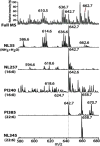Multidimensional mass spectrometry-based shotgun lipidomics analysis of vinyl ether diglycerides
- PMID: 25822162
- PMCID: PMC4474766
- DOI: 10.1007/s00216-015-8640-3
Multidimensional mass spectrometry-based shotgun lipidomics analysis of vinyl ether diglycerides
Abstract
Diglycerides play a central role in lipid metabolism and signaling in mammalian cells. Although diacylglycerol molecular species comprise the majority of cellular diglycerides that are commonly measured using a variety of approaches, identification of extremely low abundance vinyl ether diglycerides has remained challenging. In this work, representative molecular species from the three diglyceride subclasses (diacyl, vinyl ether, and alkyl ether diglycerides; hereafter referred to as diradylglycerols) were interrogated by mass spectrometric analysis. Product ion mass spectra of the synthesized diradylglycerols with varied chain lengths and degrees of unsaturation demonstrated diagnostic fragmentation patterns indicative of each subclass. Multidimensional mass spectrometry-based shotgun lipidomics (MDMS-SL) analysis of mouse brain and heart lipid extracts were performed using the identified informative signature product ions. Through an array of tandem mass spectrometric analyses utilizing the orthogonal characteristics of neutral loss scanning and precursor ion scanning, the differential fragmentation of each subclass was exploited for high-yield structural analyses. Although molecular ion mass spectra readily identified diacylglycerol molecular species directly from the hexane fractions of tissue extracts enriched in nonpolar lipids, molecular ion peaks corresponding to ether-linked diglycerides were not observable. The power of MDMS-SL utilizing the tandem mass spectrometric array analysis was demonstrated by identification and profiling of individual molecular species of vinyl ether diglycerides in mouse brain and heart from their undetectable molecular ion peaks during MS(1) analysis. Collectively, this technology enabled the identification and profiling of previously inaccessible vinyl ether diglyceride molecular species in mammalian tissues directly from extracts of biologic tissues.
Figures






Similar articles
-
Lyso-form fragment ions facilitate the determination of stereospecificity of diacyl glycerophospholipids.Rapid Commun Mass Spectrom. 2011 Jan 15;25(1):205-17. doi: 10.1002/rcm.4846. Rapid Commun Mass Spectrom. 2011. PMID: 21157865
-
Automated lipid identification and quantification by multidimensional mass spectrometry-based shotgun lipidomics.Anal Chem. 2009 Jun 1;81(11):4356-68. doi: 10.1021/ac900241u. Anal Chem. 2009. PMID: 19408941 Free PMC article.
-
Differential metabolism of diradyl glycerol molecular subclasses and molecular species by rabbit brain diglyceride kinase.J Biol Chem. 1990 Jul 25;265(21):12280-6. J Biol Chem. 1990. PMID: 2165056
-
Shotgun lipidomics: multidimensional MS analysis of cellular lipidomes.Expert Rev Proteomics. 2005 Apr;2(2):253-64. doi: 10.1586/14789450.2.2.253. Expert Rev Proteomics. 2005. PMID: 15892569 Review.
-
Strategies to Improve/Eliminate the Limitations in Shotgun Lipidomics.Proteomics. 2020 Jun;20(11):e1900070. doi: 10.1002/pmic.201900070. Epub 2019 Aug 8. Proteomics. 2020. PMID: 31291508 Free PMC article. Review.
Cited by
-
A relative quantitative positive/negative ion switching method for untargeted lipidomics via high resolution LC-MS/MS from any biological source.Metabolomics. 2017 Mar;13(3):30. doi: 10.1007/s11306-016-1157-8. Epub 2017 Feb 7. Metabolomics. 2017. PMID: 28496395 Free PMC article.
-
Shotgun Lipidomics Approach to Stabilize the Regiospecificity of Monoglycerides Using a Facile Low-Temperature Derivatization Enabling Their Definitive Identification and Quantitation.Anal Chem. 2016 Oct 4;88(19):9459-9468. doi: 10.1021/acs.analchem.6b01862. Epub 2016 Sep 26. Anal Chem. 2016. PMID: 27532157 Free PMC article.
-
Effect of Heavy Ion 12C6+ Radiation on Lipid Constitution in the Rat Brain.Molecules. 2020 Aug 18;25(16):3762. doi: 10.3390/molecules25163762. Molecules. 2020. PMID: 32824857 Free PMC article.
-
Deep profiling of plasmalogens by coupling the Paternò-Büchi derivatization with tandem mass spectrometry.Anal Bioanal Chem. 2024 Aug;416(19):4397-4407. doi: 10.1007/s00216-024-05376-9. Epub 2024 Jun 11. Anal Bioanal Chem. 2024. PMID: 38861160
-
Lipid Biomarkers in Acute Myocardial Infarction Before and After Percutaneous Coronary Intervention by Lipidomics Analysis.Med Sci Monit. 2018 Jun 18;24:4175-4182. doi: 10.12659/MSM.908732. Med Sci Monit. 2018. PMID: 29913478 Free PMC article.
References
-
- Makide K, Kitamura H, Sato Y, Okutani M, Aoki J. Emerging lysophospholipid mediators, lysophosphatidylserine, lysophosphatidylthreonine, lysophosphatidylethanolamine and lysophosphatidylglycerol. Prostaglandins Other Lipid Mediat. 2009;89(3–4):135–139. doi: 10.1016/j.prostaglandins.2009.04.009. - DOI - PubMed
Publication types
MeSH terms
Substances
Grants and funding
LinkOut - more resources
Full Text Sources
Other Literature Sources

